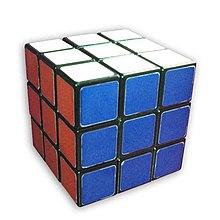 | |
| Other names | Magic Cube, Speed Cube, Puzzle Cube, Cube |
|---|---|
| Type | Combination puzzle |
| Inventor(s) | Ernő Rubik |
| Company | Rubik's Brand Ltd (Spin Master)[1] |
| Country | Hungary |
| Availability | 1977: as Hungarian Magic Cube, first test batches released in Budapest As Rubik's Cube, worldwide, 1980–present |
| Official website | |

The Rubik's Cube is a 3D combination puzzle invented in 1974[2][3] by Hungarian sculptor and professor of architecture Ernő Rubik. Originally called the Magic Cube,[4] the puzzle was licensed by Rubik to be sold by Pentangle Puzzles in the UK in 1978,[5] and then by Ideal Toy Corp in 1980[6] via businessman Tibor Laczi and Seven Towns founder Tom Kremer.[7] The cube was released internationally in 1980 and became one of the most recognized icons in popular culture. It won the 1980 German Game of the Year special award for Best Puzzle. As of January 2024[update], around 500 million cubes had been sold worldwide,[8][9][10] making it the world's bestselling puzzle game[11][12] and bestselling toy.[13] The Rubik's Cube was inducted into the US National Toy Hall of Fame in 2014.[14]
On the original, classic Rubik's Cube, each of the six faces was covered by nine stickers, with each face in one of six solid colours: white, red, blue, orange, green, and yellow. Some later versions of the cube have been updated to use coloured plastic panels instead. Since 1988, the arrangement of colours has been standardised, with white opposite yellow, blue opposite green, and orange opposite red, and with the red, white, and blue arranged clockwise, in that order.[15] On early cubes, the position of the colours varied from cube to cube.[16]
An internal pivot mechanism enables each face to turn independently, thus mixing up the colours. For the puzzle to be solved, each face must be returned to having only one colour. The Cube has inspired other designers to create a number of similar puzzles with various numbers of sides, dimensions, and mechanisms.
Although the Rubik's Cube reached the height of its mainstream popularity in the 1980s, it is still widely known and used. Many speedcubers continue to practice it and similar puzzles, and to compete for the fastest times in various categories. Since 2003, the World Cube Association (WCA), the international governing body of the Rubik's Cube, has organised competitions worldwide and has recognised world records.
- ^ Evans, Pete (27 October 2020). "Canadian company that owns classic toys Etch A Sketch and Aerobie buys Rubik's Cube for $50M". CBC News.
- ^ Fotheringham, William (2007). Fotheringham's Sporting Pastimes. Anova Books. p. 50. ISBN 978-1-86105-953-6.
- ^ de Castella, Tom (28 April 2014). "The people who are still addicted to the Rubik's Cube". BBC News Magazine. BBC. Retrieved 28 April 2014.
- ^ Cite error: The named reference
:0was invoked but never defined (see the help page). - ^ "25th Anniversa[r]y of Erno Rubik's Magic Cube. First introduced to the Western World by Pentangle Puzzles in 1978". puzzlemuseum.com. Retrieved 29 November 2020.
- ^ Daintith, John (1994). A Biographical Encyclopedia of Scientists. Bristol: Institute of Physics Pub. p. 771. ISBN 0-7503-0287-9.
- ^ Michael Shanks (8 May 2005). "History of the Cube". Stanford University. Archived from the original on 20 January 2013. Retrieved 26 July 2012.
- ^ Prakash, Prarthana. "How the Rubik's Cube has lived to 50 years—and continues to be popular among members of Gen Z and beyond". Fortune Europe. Retrieved 3 April 2024.
- ^ Adams, William Lee (28 January 2009). "The Rubik's Cube: A Puzzling Success". Time. Archived from the original on 1 February 2009. Retrieved 5 February 2009.
- ^ Jamieson, Alastair (31 January 2009). "Rubik's Cube inventor is back with Rubik's 360". The Daily Telegraph. London. Archived from the original on 11 January 2022. Retrieved 5 February 2009.
- ^ "eGames, Mindscape Put International Twist on Rubik's Cube PC Game". Reuters. 6 February 2008. Archived from the original on 12 February 2009. Retrieved 6 February 2009.
- ^ Marshall, Ray. "Squaring up to the Rubchallenge". Archived from the original on 20 January 2013. Retrieved 15 August 2005.
- ^ "Rubik's Cube 25 years on: crazy toys, crazy times". The Independent. London. 16 August 2007. Retrieved 6 February 2009.
- ^ "National Toy Hall Of Fame 2014 - CBS News". CBS News. 6 November 2014.
- ^ Dempsey, Michael W. (1988). Growing up with science: The illustrated encyclopedia of invention. London: Marshall Cavendish. p. 1245. ISBN 0-87475-841-6.
- ^ Ewing, John; Czes Kosniowski (1982). Puzzle It Out: Cubes, Groups and Puzzles. Cambridge: Press Syndicate of the University of Cambridge. p. 4. ISBN 0-521-28924-6. Retrieved 19 May 2014.